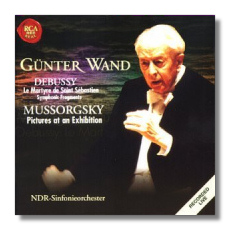
The Internet's Premier Classical Music Source
Related Links
-
Debussy Reviews
Mussorgsky Reviews - Latest Reviews
- More Reviews
-
By Composer
-
Collections
DVD & Blu-ray
Books
Concert Reviews
Articles/Interviews
Software
Audio
Search Amazon
Recommended Links
Site News
 CD Review
CD Review
Günter Wand Conducts

Debussy & Mussorgsky
- Claude Debussy: Symphonic fragments from Le Martyre de Saint Sébastien
- Modest Mussorgsky: Pictures at an Exhibition (orch. Ravel)
North German Radio Symphony Orchestra/Günter Wand
RCA Victor Red Seal 74321-72788-2 DDD? 54:31
We are used to hearing Wand conduct a limited repertoire on CD; mostly superb Bruckner, then Brahms, with some Beethoven and Schubert for good measure. It may surprise listeners a little, as it did me, to hear him conducting Debussy and Mussorgsky, two composers who are not associated with Germanic seriousness.
There's a reason for this coupling, however. Wand became the official conductor of the North German Radio Symphony Orchestra in Hamburg in 1982, and his first "home" concerts took place on September 19 and 20 of that year. The program included music from Debussy's Le Martyre de Saint Sébastien and Mussorgsky's Pictures at an Exhibition in the orchestration by Maurice Ravel. The September 20 performance of the Debussy occupies the first half of this disc. A composite performance of the Mussorgsky, taken from concerts in late February 1999, occupies the second half. In this manner, this CD recalls Wand's earliest days with the Hamburg-based orchestra and reminds us that he continues to be active with this orchestra in the role of lifetime Honorary Conductor.
Wand had been conducting the Debussy for 15 years (not continuously!) by the time he performed it with the North German Radio Symphony Orchestra. Other conductors have taken a gauzier approach to Debussy's masochistic mysticism, and other orchestras have had a timbre that was more appropriate for this music. (If you want to hear a classic version of this score, try Charles Munch and the Boston Symphony Orchestra on RCA Victor Gold Seal. Not only does Munch include music omitted from these "fragments," he even recites d'Annunzio's text with fantastic ardor and nobility.) Wand is more restrained, but his restraint and his sense of line come together to create a reading that has a strong backbone; it's a moving performance that raises goose bumps when it is at its most quiet. The end of "Le Bon Pasteur" seems to glow.
Predictably, Wand does not treat Pictures as an orchestral or sonic showpiece, although it would wrong to say that his reading doesn't raise goose bumps of a different sort. An interesting point about this performance, which Wand previews in the booklet notes, is the metric relationship between the work's sections. He says, "[The] pulse running through the entire score has an inherent logic and creates an inner tension, helping the work to avoid the character of a suite. Not only are there obvious tempo relationships between the movements, the work has a strong overall compositional structure, too." This means that some sections are faster than we are used to, and others are slower. The tempos work, though, and they make sense. Sure enough, this recording of Pictures is characterized by the music's unstoppable flow. Listeners who are looking for "wow" effects – and there's nothing wrong with that – will need to look elsewhere. The orchestra plays capably, if without the virtuosity that the Chicago Symphony Orchestra, for example, brings to this work.
The booklet notes, with comments by Wand and others, are excellent; 12 pages of English text alone are reserved for the compositions and their composers. I couldn't find a SPARS code; I am thinking that, given the date, the Debussy may be an analogue recording, and the Mussorgsky may be digital. There's little difference between the two, however.
Copyright © 2000, Raymond Tuttle


















